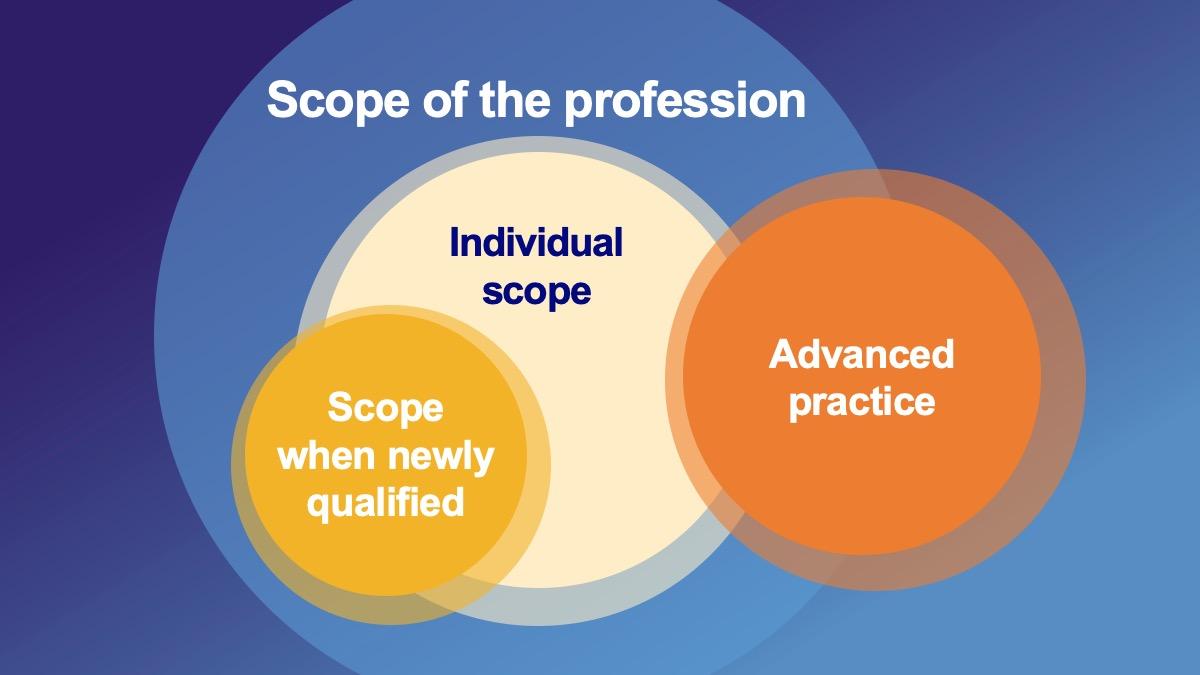There are two aspects to scope: the scope of the profession and your individual scope. It is important that you understand both as they will have implications for your practice.

The four pillars of physiotherapy are:
- manual therapy and therapeutic handling
- exercise, movement and rehabilitation
- therapeutic and diagnostic technologies
- allied approaches
Find out more about the history and context of scope of practice.
The scope of the physiotherapy profession is defined as any activity undertaken by an individual physiotherapist within the four pillars of physiotherapy practice.
Such activities are linked to existing or emerging occupational and/or practice frameworks acknowledged by the profession, and supported by a body of evidence.
Your individual scope (capability) of practice describes the physiotherapy work that you are educated, trained and competent to carry out. This will be unique to you and is influenced by your career, experience and development.
Frequently asked questions
I have a new role as a case manager for an occupational health company. Is this considered to be within the scope of the profession?
Yes. Practising your profession includes all activities that draw upon your professional knowledge and skills gained from pre- and post-registration practice. This includes not only direct clinical practice but also roles in education, management, research, policy and leadership.
I have completed an acupuncture course but not one that is recognised by the Acupuncture Association of Chartered Physiotherapists (AACP). Am I now able to practise acupuncture? Is this deemed to be within my individual scope?
Yes. You can decide when you have the necessary knowledge training and competence to extend your scope. The Health and Care Professions Council (HCPC) doesn’t prescribe how you can achieve competence, and maintain and evolve your individual scope of practice. However, it does expect you to engage in continuous professional development (CPD). You must be able to demonstrate if asked, how you have developed and maintained that competence and while that may be achieved by attending a course, learning from peers and reflective practice are equally valid.
The only exception is any registrant who considers prescribing to be within their individual scope, as they must have sucessfully completed an accredited post-registration qualification and been annotation on the HCPC register as a prescriber.
Why has the CSP decided that complementary, alternative and holistic (CAH) therapies are no longer within scope of the profession?
The CSP continually reviews areas of risk in respect of the practice of physiotherapy, including the expectations, principles and reputation of physiotherapy as a healthcare profession.
It is clear that many complementary, alternative and holistic (CAH) therapies do not have a robust current or emergent evidence base for effectiveness. In March 2021 the member-led Professional Committee of the CSP made a decision that CAH therapies are not part of physiotherapy practice and thus not covered by the CSP PLI scheme . Examples of CAH therapies include, reflexology, aromatherapy, Reiki, cupping and energy medicine.
Am I a delivering an exercise class as an exercise instructor or a physiotherapist?
Only you can answer this question, and you may wish to do both at different times. You must be aware that there is a difference between the two activities and how you practise will affect what insurance you need.
When you take classes as a physiotherapist, you must deliver the reasonable ‘standard of care’ of a physiotherapist, which will include appropriate examination, clinical reasoning and professional judgment in all your decisions relating to the participation of your clients in the programme. Record-keeping is essential to help you demonstrate, if challenged, that you were working as a physiotherapist.
The level and complexity of record-keeping required will vary according to the context of the class and the background health status of your clients. Particularly where the client group is inherently healthy with no underlying health issues, there is no reason why a screening checklist completed by the clients should not serve as adequate assessment. Retaining these assessments and/or a class/client register with space for comments can serve as documentation.
How is it decided what new and evolving activities fall within the scope of the profession?
The ‘allied approaches’ pillar allows room for the profession to evolve in the light of new practice developments, but such advances must be based on scientific evidence and be recognised by peers as being physiotherapy. It is not a pillar that allows members to bring anything and everything under the umbrella of physiotherapy practice. We often receive member enquiries asking whether a new kind of electrotherapy or technique falls within the scope of the profession. The important thing you must evaluate is whether the proposed intervention has a robust or emergent evidence base for effectiveness and would be recognised by physiotherapy experts.
You should therefore consider:
- What does the research evidence say? Has this been published in a peer review journal? We expect there to be more than one or two quality articles in support of the development.
- Does the research evidence show additional or equivalent benefits to current best practice?
- If it is a medical device, what standards does it conform to?
- What evidence is there to support its use for the physiotherapy purpose you intend to use it for? You may find our guides to help you search our online databases helpful.
- Would peers and our professional networks recognise this as physiotherapy?

